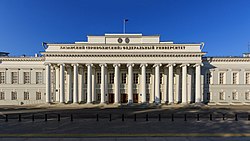Казанский (Приволжский) федеральный университет | |
 | |
| Latin: Universitas Casanensis[1] | |
Former names | Vladimir Ulyanov-Lenin Kazan State University, Imperial Kazan University |
|---|---|
| Type | Public/Federal university |
| Established | November 17, 1804[2] |
| Rector | Lenar Safin |
Academic staff | ~ 4400 |
| Students | ~ 50200 |
| Address | 18 Ulitsa Kremlevskaya , , , Russia 55°47′27″N 49°07′19″E / 55.7907°N 49.1219°E |
| Campus | Both urban and suburban |
| Language | Russian, English, Tatar |
| Colours | Blue and white |
| Affiliations | EUA IAU EURAS AMBA |
| Website | eng.kpfu.ru |
 | |
Kazan (Volga region) Federal University (Russian: Казанский (Приволжский) федеральный университет, Tatar: Казан (Идел буе) федераль университеты, romanized: Qazan (İdel buyı) federal universitetı) is a public research university located in Kazan, Russia.
The university was founded in 1804 as Imperial Kazan University, which makes it the second oldest continuously existing tertiary education institution in Russia. Founder of non-Euclidean geometry Nikolai Ivanovich Lobachevsky served there as the rector from 1827 until 1846. In 1925, the university was renamed in honour of its student Vladimir Ilyich Ulyanov (Lenin). The university is known as the birthplace of organic chemistry due to works by Aleksandr Butlerov, Vladimir Markovnikov, Aleksandr Arbuzov, and the birthplace of electron spin resonance discovered by Evgeny Zavoisky.
In 2011, Kazan University received a federal status. It is also one of 18 Russian universities that were initially selected to participate in the Project 5-100, coordinated by the Government of the Russian Federation and aimed to improve their international competitiveness among the world's leading research and educational centers.[3] In 2021, KFU joined Priority 2030, Russia's new academic excellence project.[4]
As of early 2023, the university comprised 20 primary educational units, 3 of which were territorial branches, including one overseas branch in Uzbekistan.[5] More than 52,000 students were enrolled in over 600 degree programs at undergraduate and postgraduate level (including doctoral and double-degree programs with partner universities); the number of international students was about 11,500 from 101 countries.[6] Current research priorities are biomedicine, materials science, hydrocarbon industry, new energy sources, IT and cyber-physical systems, and comprehensive development of human potential.[7]
- ^ Records of The Tercentenary Festival of Dublin University. Dublin, Ireland: Hodges, Figgis & Co. 1894. ISBN 9781355361602.
- ^ 5 November 1804 (O.S.)
- ^ "The university-participants in the Project 5-100 present their roadmaps". Проект 5-100: Российское образование мирового класса!. Retrieved 2020-01-17.
- ^ "Priority 2030 – Kazan Federal University". eng.kpfu.ru. Retrieved 2023-03-10.
- ^ "Jizzakh Branch (Uzbekistan) – Kazan Federal University". eng.kpfu.ru. Retrieved 2023-03-10.
- ^ "Facts, Figures, Rankings – Kazan Federal University". eng.kpfu.ru. Retrieved 2023-03-10.
- ^ "Priority 2030 – Kazan Federal University". eng.kpfu.ru. Retrieved 2023-03-10.